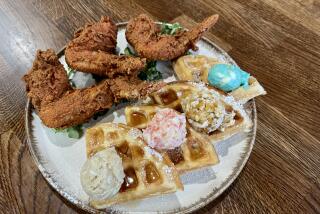Recipe Decoder
- Share via
Key to Times Style
Butter: unsalted (sweet), unless otherwise indicated.
Eggs: large, unless otherwise indicated.
Milk: whole, unless otherwise indicated.
Oil: Vegetable oil (canola, peanut, safflower, etc.), unless otherwise indicated.
Glossary
New Zealand Mussels: Large, green-lipped mussels. Some chefs like them because of the way they look, even though their flavor may be relatively strong. Others prefer black mussels for their sweeter flavor.
Egg Bread: Most breads are made from yeast, flour, water and salt. Adding fat to the dough--whether in the form of butter or eggs--makes a crumb that is soft and fine. Perhaps the most famous egg bread is Jewish challah.
Kneading: A way of mixing doughs that can be either very rough--as for bread--or very gentle--as for pastries. Though bread dough can be punched, slapped and slammed, kneading a pastry calls for gently rolling and pressing the dough until it is smooth and cohesive.
Lessons
Cutting Butter Into Flour: This is the first step in making pastry. The finished texture should be either fine as cornmeal or coarse as pebbles, depending on whether the desired crust is short or flaky, respectively.
Measuring Flour: There are many ways to measure flour. The most accurate is to spoon the flour into the measuring cup, then scrape the flat back of a knife blade across the top to level it.
Shellfish Stock: Much of the flavor in such shellfish as lobster, shrimp and crayfish is carried in the fat, which clings to the inside of the shells. You can make a nice stock from them by simply simmering the crushed shells with assorted vegetables for 45 minutes.


